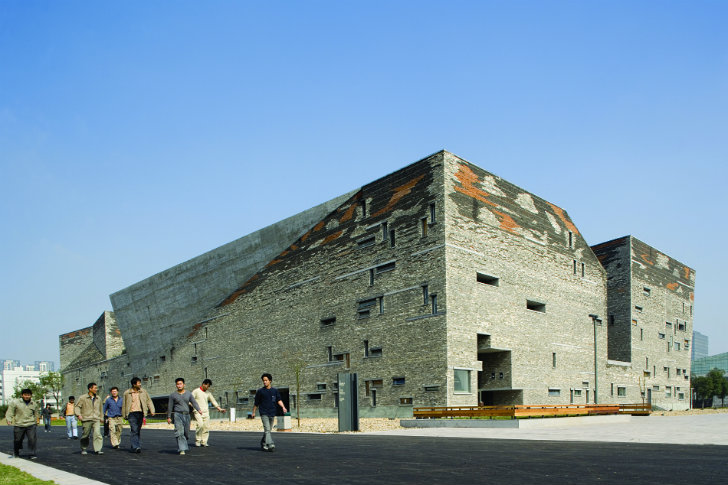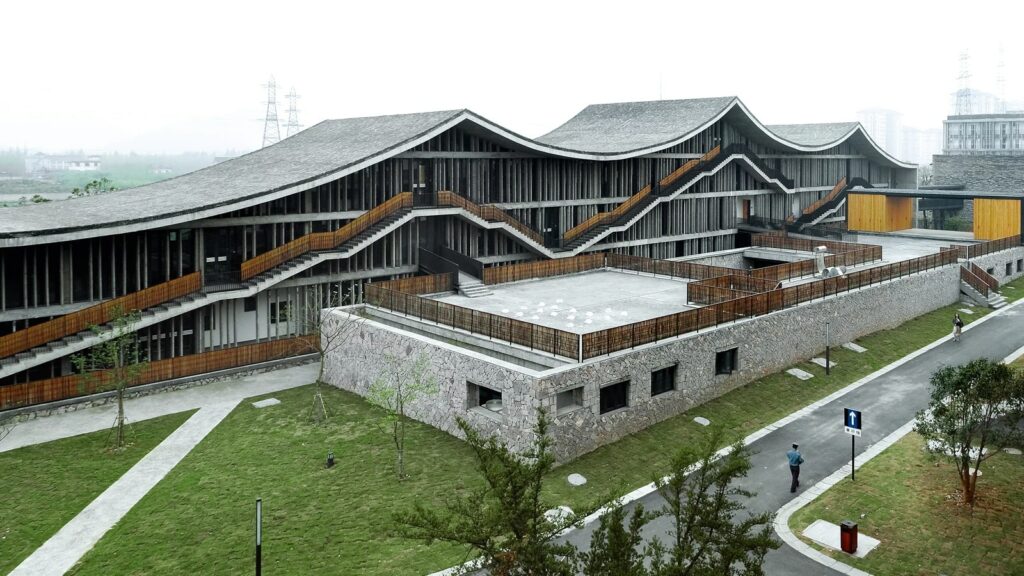Image: Hyatt Foundation.




A 2-day immersion into the future of sustainable construction
Introduction
Wang Shu, a beacon in the world of architecture, crafts spaces that breathe tradition into the modern skeleton of urban landscapes. As the first Chinese citizen to clinch the prestigious Pritzker Prize, he has not just built structures; he has sculpted a narrative of cultural reverence and innovation. This article dives into the life of an architect who sees buildings not just as structures, but as stories and experiences entrenched in everyday life.
Wang Shu: Early Life and Education
Growing Up with Creativity
Wang Shu’s journey into the architectural world began in Urumqi, nestled in the heart of China. Born to a librarian mother and a musician father who was also an amateur carpenter, Wang’s childhood was steeped in a mix of scholarly pursuits and creative endeavors.
Wang Shu Academic Pursuits
His academic path was as structured as it was inspiring:
- 1985: Graduated from the Nanjing Institute of Technology with a Bachelor’s degree in architecture.
- 1988: Master’s degree capped off his formal education, but it was just the beginning of his real-world explorations.
Table: Wang Shu’s Academic Timeline
| Year | Milestone |
|---|---|
| 1985 | Bachelor’s degree in architecture |
| 1988 | Master’s degree from Nanjing Institute |
Founding of Amateur Architecture Studio
A Partnership Forged in Design
In 1997, Wang Shu and Lu Wenyu, his wife and professional partner, founded the Amateur Architecture Studio. The studio’s name is a manifesto in itself—declaring a philosophy of spontaneity and experimentation against the backdrop of increasingly commercialized architecture.
Wang Shu: Philosophy and Method
Wang Shu’s designs echo the landscapes of his projects, incorporating local materials and traditional techniques. This approach not only pays homage to historical Chinese architectural styles but also challenges the modern era’s disconnect between culture and construction. Here’s how the studio stands out:
- Materials: Use of recycled and locally sourced materials.
- Design: Integration of traditional Chinese aesthetics with modern functionality.
- Philosophy: Resistance to the impersonal and industrial aspects of contemporary architecture.
List of Key Philosophical Tenets:
- Emphasis on integrating architecture with its environmental and cultural context.
- Advocacy for the use of traditional materials and methods in modern designs.
- Focus on sustainability and the environmental impact of construction.
These foundations have not only defined Wang Shu’s architectural signature but have also set a benchmark in how architecture interacts with culture and environment, making every structure a living part of its locale. Through this lens, we see not just buildings, but the revival of a narrative as old as the civilizations they stand within.
Philosophical Foundations
Embracing Amateur Architecture
The term ‘amateur’ in Amateur Architecture Studio isn’t about a lack of professionalism; rather, it symbolizes an avant-garde approach to architectural design, emphasizing creativity and personal involvement over commercial gain. Wang Shu uses the word to describe a preference for the experimental and the intuitive over the strictly planned and corporate. His philosophy centers on the belief that architecture should be a direct response to its environment and culture, not a bland, universal template imposed regardless of context【8†source】.
Wang Shu: Everyday Life as Inspiration
For Wang Shu, architecture is an extension of life. It’s not about creating monuments, but about crafting spaces that improve, enrich, and fit into the daily lives of the people who use them. This philosophy stems from his views on the role of architecture in society—a tool for community enhancement rather than mere aesthetic statements. His approach involves a deep engagement with the site’s history and cultural background, integrating traditional materials and techniques to produce designs that speak to both past and present. His notable assertion that he builds ‘houses’ instead of ‘buildings’ underscores his focus on human-centric, approachable, and livable spaces.
Wang Shu Major Architectural Projects
Signature Works and Architectural Mastery
Wang Shu’s portfolio is a testament to his philosophy of deeply contextual and culturally responsive architecture. Each project is a narrative in itself, celebrated not only for its aesthetic qualities but also for its integration into the cultural and environmental fabric of its location. Some of his most acclaimed projects include:


Photo: ©Lv Hengzhong
- Ningbo Museum: A structure famed for its use of recycled materials and its embodiment of local history and cultural identity.


Photo: Iwan Baan
- Xiangshan Campus: Notable for its seamless blend of modern academic needs with traditional architectural forms.
Innovative Design Techniques
Each of Wang Shu’s designs is marked by a distinctive use of materials and forms that reflect the local environment and heritage. His approach often involves sustainable practices, such as the reuse of construction debris and locally sourced materials, which not only conserves resources but also gives each building a unique, contextual identity. This method has not only won him international acclaim but also set a precedent for sustainable and culturally mindful architecture around the world.
Wang Shu: Materials and Sustainability
Innovative Use of Recycled Materials
Wang Shu’s approach to architecture prominently features the use of recycled materials, a testament to his commitment to sustainability. His projects often incorporate items reclaimed from demolition sites, such as the 66,000 tiles used in the “Tiled Garden” installation at the Venice Architecture Biennale. This practice not only reduces the environmental impact of construction but also infuses his buildings with historical continuity and local identity.
Principles of Sustainable Design
Sustainability in Wang Shu’s work is not just about materials but also involves energy-efficient designs and integration with natural landscapes. His buildings are designed to take advantage of natural light and ventilation, minimizing the need for artificial heating and cooling. This holistic approach to sustainability respects the environment and enhances the functionality and comfort of his architectural designs.
Wang Shu Cultural and Historical Context
Reflecting Chinese Heritage
Wang Shu’s architecture deeply engages with the cultural and historical contexts of its locations. His works are not mere structures but serve as modern custodians of the rich Chinese architectural legacy. By integrating traditional Chinese architectural elements like courtyards, gardens, and decorative tiles, Wang Shu creates spaces that reflect and honor the past while serving contemporary needs.
Integration into Modern Urban Landscapes
Despite his focus on tradition, Wang Shu’s designs competently address the challenges of modern urban environments. They are not isolated artifacts of nostalgia but are fully functional parts of the cities they inhabit. His ability to weave historical sensitivity with modern requirements makes his projects exemplary models of cultural sustainability in urban design, ensuring they are both relevant and resonant in today’s architectural discourse.
Wang Shu Awards and Recognitions
A Prolific Award-Winning Career
Wang Shu’s architectural genius has been recognized globally through numerous prestigious awards. Most notably, he was awarded the Pritzker Prize in 2012, marking him as the first Chinese citizen to receive this honor. This accolade is often regarded as the Nobel Prize of architecture, underscoring his significant impact on the field. Wang Shu’s work has also been celebrated with other awards including the Gold Medal of Architecture from the French Academy of Architecture and the Schelling Architecture Prize.
Recognition Beyond Awards
Beyond formal awards, Wang Shu’s recognition extends into influential academic roles and invitations to prestigious events. He has served as the Kenzo Tange Visiting Professor at Harvard, a testament to his profound influence on architectural education. His engagements at international exhibitions, like the Venice Biennale, further illustrate his standing in the global architectural community, where he consistently contributes to discourse on sustainable and culturally resonant architecture.
Wang Shu Critiques and Controversies
Navigating Professional Criticism
Wang Shu’s architectural philosophy and practices, while widely acclaimed, have not been without criticism. Some critics argue that his approach, heavily focused on historical elements and traditional techniques, might limit the functionality and adaptability of his designs in modern urban settings. These critiques often highlight the challenges of integrating traditional architectural elements within the fast-paced development of modern cities.
The Controversy of Collaboration
A significant controversy in Wang Shu’s career arose with his Pritzker Prize win, where many felt that his wife and long-time collaborator, Lu Wenyu, should have shared the recognition. This sparked a broader discussion on the visibility and acknowledgment of collaborative roles in architectural practices. Wang Shu himself has acknowledged Lu Wenyu’s integral role in their shared projects, highlighting the often-overlooked contributions of partners in the architecture field. This controversy has opened up conversations about recognition and equality in architecture, underlining the importance of crediting all individuals who contribute to a project’s success.
Wang Shu: Teaching and Academic Contributions
Influencing New Generations
Wang Shu’s influence extends far beyond his architectural projects into the realms of education and mentorship. As a professor and the head of the Architecture School at the China Academy of Art, he has guided numerous students through the intricate world of architectural design. His teachings emphasize the importance of integrating cultural identity with modern architectural practices, inspiring students to consider sustainable and context-aware designs in their own work.
Key Educational Positions and Influence
- Professor at China Academy of Art: Fostered a new generation of architects.
- Kenzo Tange Visiting Professor at Harvard: Brought his unique perspectives to students internationally.
Future Projects and Direction
Ongoing and Upcoming Endeavors
Wang Shu continues to push the boundaries of architecture with ongoing and future projects that promise to further blend modernity with tradition. His forward-thinking designs remain grounded in sustainability and cultural relevance, promising to bring innovative solutions to contemporary architectural challenges.
Vision for Future Architecture
Looking ahead, Wang Shu aims to further explore the integration of environmental sustainability with urban development, advocating for designs that respect both heritage and modern efficiency. His future projects are anticipated to be benchmarks in sustainable urban planning, potentially influencing city landscapes around the world.
Conclusion
Wang Shu’s Architectural Legacy
Wang Shu’s architectural career is a profound testament to the power of blending historical reverence with modern innovation. His work not only transforms skylines but also enriches the cultural tapestry of each locale it touches. Through his unique approach to design, Wang Shu has redefined what it means to be a modern architect in a rapidly changing world.
Final Thoughts
As we continue to face global challenges in sustainability and cultural preservation, Wang Shu’s contributions offer valuable insights and inspiration for both current and future architects. His legacy is not just in the structures he has created but in the philosophical shift he has inspired towards more thoughtful and contextually engaged architecture.
List of Key Contributions:
- Pioneering sustainable and culturally integrated architecture.
- Educating and influencing future generations of architects.
- Setting a global standard for architectural excellence and integrity.
Wang Shu’s journey from a thoughtful student of architecture to a master of the craft underscores a career built on integrity, innovation, and a profound respect for the past. His works continue to inspire and challenge the norms of architectural design, making him not just a creator of buildings but a builder of legacies.
If you want o learn about our consultancies in Portuguese language, click here.






A 2-day immersion into the future of sustainable construction

